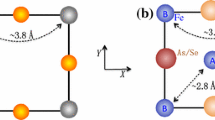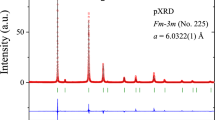Abstract
The properties of the superconducting transition temperatureT cof the CuAl 2 -type compounds of Zr 2 Co, Zr 2 Ni, Zr 2 Rh, Zr 2 Fe, and Zr 2 Ir are discussed with respect to effects due to alloying and heat treatment. Dilute pseudobinary alloys of transition-metal elements with Zr 2 Rh (T c=11.3 K) produced lower transition temperatures suggesting that the valence-electron concentration of 5.67 electrons/atom gives a maximum inT c for this crystal type. Results for Zr 2 Co (T c=5.0 K) and Zr 2 Ir (T c=7.3 K) show that their transition temperatures are raised somewhat when the electron concentration is increased by alloying. A peak is seen near 5.72 electrons/atom. A peak in the room-temperature magnetic susceptibility in the Zr 2 Co-Zr 2 Ni system occurs near the same electron concentration as the peak inT c. Similar susceptibility behavior takes place in the Zr 2 Rh-Zr 2 Ni system, however, with no peak inT c. Results of susceptibility measurements on Zr 2 Ir and its isomorphic alloys indicate correlation betweenT c and susceptibility. An anticorrelation occurs for Zr 2 Co alloys suggesting the presence of Coulomb interactions. A sharp symmetric drop inT c near the stoichiometric composition as well as a marked decrease of the transition temperature with a low-temperature (600 C) anneal indicate that the coulomb interactions are sensitive to crystalline order. The lattice parameters of Zr 2 Ir are reported as a=6.508 Å andc=5.721 Å. The superconductivity of Zr 3 Co (T c=3.9 K) and Zr 3 Ir (T c=2.13 K) is reported.
Similar content being viewed by others
References
B. T. Matthias,Phys. Rev. 100, 626 (1955).
S. T. Zegler,J. Phys. Chem. Solids 26, 1347 (1964).
A. Raman and K. Schubert,Z. Metallk. 55, 704 (1964).
Yu. B. Kuz'ma, V. Ya. Markiv, Yu. V. Voroshilov, and R. V. Skolozdra,Izv. Akad. Nauk SSSR, Neorganische Materialy 2, 259 (1963).
Kazuhiko Yamaya, Takashi Sambongi, and Todayasu Mitsui,J. Phys. Soc. Japan 29, 879 (1970).
J. Bardeen, L. N. Cooper, and J. R. Schrieffer,Phys. Rev. 108, 1175 (1957).
D. Wohlleben, Ph.D. thesis, University of California at San Diego, 1968 (unpublished).
Werner Buckel, Gerald Dummer, and Wolfgang Gey,Phys. Kondensierten Materie 1, 67 (1963).
Ch. J. Raub and C. A. Anderson,Z. Physik 175, 105 (1963).
P. I. Krypyakevich, V. Ya. Markiv, and V. V. Burnashova,Dopovidi Akad. Nauk Ukr. RSR, A(6), 553 (1970).
Tapach Kumar Biswas and Konrad Schubert,Z. Metallk. 58, 558 (1967).
P. Morel and P. W. Anderson,Phys. Rev. 125, 1263 (1962).
N. F. Berk, Ph.D. thesis, University of Pennsylvania, 1966 (unpublished).
N. F. Berk and J. R. Schrieffer,Phys. Rev. Letters 17, 433 (1966).
D. M. Bailey and J. F. Smith,Acta Cryst. 14, 1084 (1961).
M. E. Kirkpatrick and W. L. Larson,Trans. Am. Soc. Metals 54, 580 (1961).
Author information
Authors and Affiliations
Additional information
Research sponsored by the Air Force Office of Scientific Research, Office of Aerospace Research, United States Air Force, under AFOSR grant number AF-AFOSR-631-67-A.
Rights and permissions
About this article
Cite this article
McCarthy, S.L. The superconductivity and magnetic susceptibility of some zirconium-transition-metal compounds; evidence for an anticorrelation. J Low Temp Phys 4, 489–501 (1971). https://doi.org/10.1007/BF00631128
Received:
Issue Date:
DOI: https://doi.org/10.1007/BF00631128




